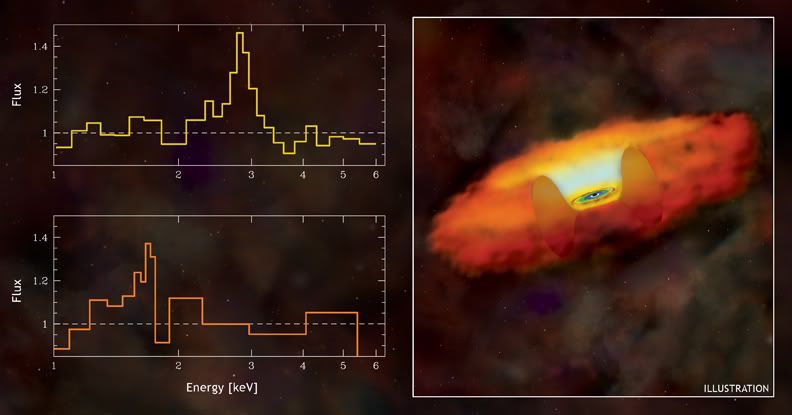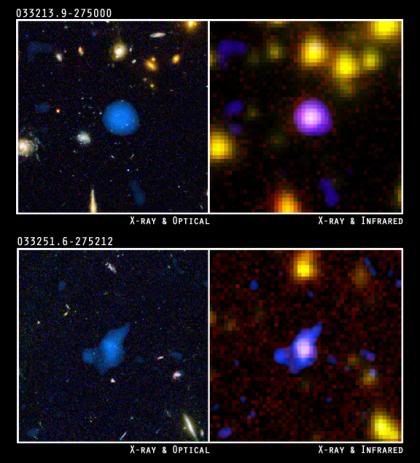Skip to comments.
Manned mission to construct huge GEO and deep space telescopes proposed
NasaSpaceflight.com ^
| 01/03/10
| Chris Bergin
Posted on 01/04/2010 5:13:28 PM PST by KevinDavis
Buoyed by the success of the Hubble Space Telescope, one of the key proposals on NASA’s internal interpretation of the Augustine Commission’s “Flexible Path” option includes a 45 day manned mission to construct a giant telescope in Geostationary orbit (GEO). A huge deep space telescope is also included in the roadmap, which would focus on a major advancement for the search of Earth-like planets.
(Excerpt) Read more at nasaspaceflight.com ...
TOPICS: Astronomy; Miscellaneous; Science
KEYWORDS: space; telescope; xplanets
Navigation: use the links below to view more comments.
first 1-20, 21-25 next last
To: Dimez_Recon; The SISU kid; Empireoftheatom48; Rio; hattend; reader25; july4thfreedomfoundation; ...

For other space news go to: http://www.spacetoday.net
For a list of Private Space Companies: http://en.wikipedia.org/wiki/List_of_private_spaceflight_companies
2
posted on
01/04/2010 5:14:42 PM PST
by
KevinDavis
(Can't Stop the Signal!)
To: KevinDavis
I can hardly wait to see some of the imagery from the
next gen space telescope.
3
posted on
01/04/2010 5:16:05 PM PST
by
rahbert
(Bop Bop, dibidip dibidip....)
To: rahbert
There are some ground based telescopes coming that will rival the space based telescopes. The adaptive optics are going to make the difference. Maintinance will be much easier and cheaper here on the ground as well.
4
posted on
01/04/2010 5:31:01 PM PST
by
cripplecreek
(Seniors, the new shovel ready project under socialized medicine.)
To: KevinDavis
No bucks...no Buck Rogers.
5
posted on
01/04/2010 5:32:13 PM PST
by
hattend
(Once we had Reagan, Johnny Cash and Bob Hope. Now we have Obama, no Cash and no Hope)
To: annie laurie; garbageseeker; Knitting A Conundrum; Viking2002; Ernest_at_the_Beach; Mmogamer; ...
6
posted on
01/04/2010 5:36:01 PM PST
by
SunkenCiv
(Happy New Year!)
To: rahbert
“I can hardly wait to see some of the imagery from the next gen space telescope.”
You mean the unclassifed ones?
7
posted on
01/04/2010 5:40:03 PM PST
by
PIF
To: KevinDavis
“Next could be a GEO Earth Looking Observatory for applications such as Greenhouse Gas Monitoring, Attribution and Compliance; Persistent Intelligence, Surveillance and Reconnaissance; and other Earth Science,” the presentation continued. Yeah, this'll be good. Riiiiiight.
8
posted on
01/04/2010 5:40:32 PM PST
by
Roccus
(ABLE DANGER?????...................What's an ABLE DANGER???)
To: KevinDavis
Unless there is a kick-back for Chicago and Murtha’s district, it will never fly, Orville!
To: KevinDavis
As much as I beat my head against the wall over NASA and the Gov throwing my money away, there are somethings I would give more of my money to. This is one of them. A technological and engineering challenge, not with a blank check, but a clear mission that pairs both the manned side of the house and the robotics side and forces teamwork to get it done. I can hope anyways.
10
posted on
01/04/2010 10:06:30 PM PST
by
Dimez_Recon
(Currahee Stryker: When in doubt, shoot more.)
To: Dimez_Recon
By why manned? Toss the scope up by itself. Toss a bunch of them up for what one manned scope mission would cost I bet.
To: PIF
No I mean the imagery of deep space, black holes, remnants of the big bang...
12
posted on
01/04/2010 10:18:03 PM PST
by
rahbert
(Bop Bop, dibidip dibidip....)
To: hattend
Who needs Buck Rogers when you have DUCK DODGERS, OF THE 24TH AND A HALF CENTURY!

13
posted on
01/04/2010 10:22:44 PM PST
by
wastedyears
(If I'm going out, I'm going out like Major Kong.)
To: rahbert
“No I mean the imagery of deep space, black holes, remnants of the big bang...”
Oh, I see, just the publicly released filtered and ‘retouched’ ones then... well, that’s something prety to look at I suppose... meaningless however.
14
posted on
01/05/2010 4:08:00 AM PST
by
PIF
To: PIF
15
posted on
01/05/2010 6:14:32 AM PST
by
rahbert
(Bop Bop, dibidip dibidip....)
To: rahbert
Using Chandra spectra obtained from more than 300 supermassive black holes in the centers of galaxies, a team of astronomers has been able to determine the amount of iron near the black holes (light blue in illustration on the right). The black holes were all located in the North and South Chandra Deep Fields, where the faintest and most-distant X-ray objects can be identified. The left side of the above graphic shows portions of X-ray spectra from a subset of 50 black holes about 9 billion light years away (upper panel), and another group of 22 black holes that are about 11 billion light years away (lower panel). The peaks in the spectra are produced by X-ray emission from iron atoms, and indicate that approximately the same amount of iron was present around black holes 9 billion years and 11 billion years in the past. Similar results corresponding to times ranging from 5 billion years to 9 billion years in the past show that the amount of iron around black holes has not changed significantly over the past 11 billion years. This implies that most of the iron in the galaxies that contain these supermassive black holes was created before the Universe was about 2 billion years old, when galaxies were very young. The distinctive X-ray spectral peaks are produced by the fluorescence of iron atoms in a doughnut-shaped torus orbiting a supermassive black hole. In this process, high-energy X-rays from hot gas very near the black hole excite the iron atoms to a higher energy state, and they almost immediately return to their lower energy state with the emission of a lower-energy, fluorescent X-ray.

16
posted on
01/05/2010 6:25:37 AM PST
by
rahbert
(Bop Bop, dibidip dibidip....)
To: rahbert
The combined powers of three of NASA's Great Observatories -- the Hubble Space Telescope, the Chandra X-ray Observatory, and the Spitzer Space Telescope -- have been used to find evidence of a hidden population of supermassive black holes in the universe. All these space telescopes took a long look at a small region of the sky (called the Great Observatories Origins Deep Survey field, or the GOODS field for short). When visible light and X-ray light from this region were compared, astronomers found numerous X-ray sources that can be identified as supermassive black holes in young galaxies billions of light years from Earth. But the X-ray glow from other sources had no obvious host galaxies in optical light. Two of these X-ray sources are identified by the central blue spots in the composite Hubble-Chandra images on the upper and lower left panels. The Chandra-Spitzer composite X-ray/infrared images on the upper and lower right panels demonstrate that these mysterious sources are also detected at infrared wavelengths. This indicates that the galaxies around these supermassive black holes are heavily obscured by dust. Visible light is absorbed by the dust, which is heated by the absorption and glows at infrared wavelengths. Astronomers have suspected that many supermassive black holes may have been missed in optical surveys because they were shrouded in dust. Combined data from Chandra, Spitzer and Hubble should soon yield a much more complete census of the number of black holes in the early universe

17
posted on
01/05/2010 6:32:32 AM PST
by
rahbert
(Bop Bop, dibidip dibidip....)
To: PIF
18
posted on
01/05/2010 6:34:27 AM PST
by
rahbert
(Bop Bop, dibidip dibidip....)
To: KevinDavis
Couldn’t we just launch a number of small satellite telescopes, and time synchronize the data to emulate one very large telescope? No scape based assembly required.
To: KevinDavis
Couldn’t we just launch a number of small satellite telescopes, and time synchronize the data to emulate one very large telescope? No spacee based assembly required.
Navigation: use the links below to view more comments.
first 1-20, 21-25 next last
Disclaimer:
Opinions posted on Free Republic are those of the individual
posters and do not necessarily represent the opinion of Free Republic or its
management. All materials posted herein are protected by copyright law and the
exemption for fair use of copyrighted works.
FreeRepublic.com is powered by software copyright 2000-2008 John Robinson



